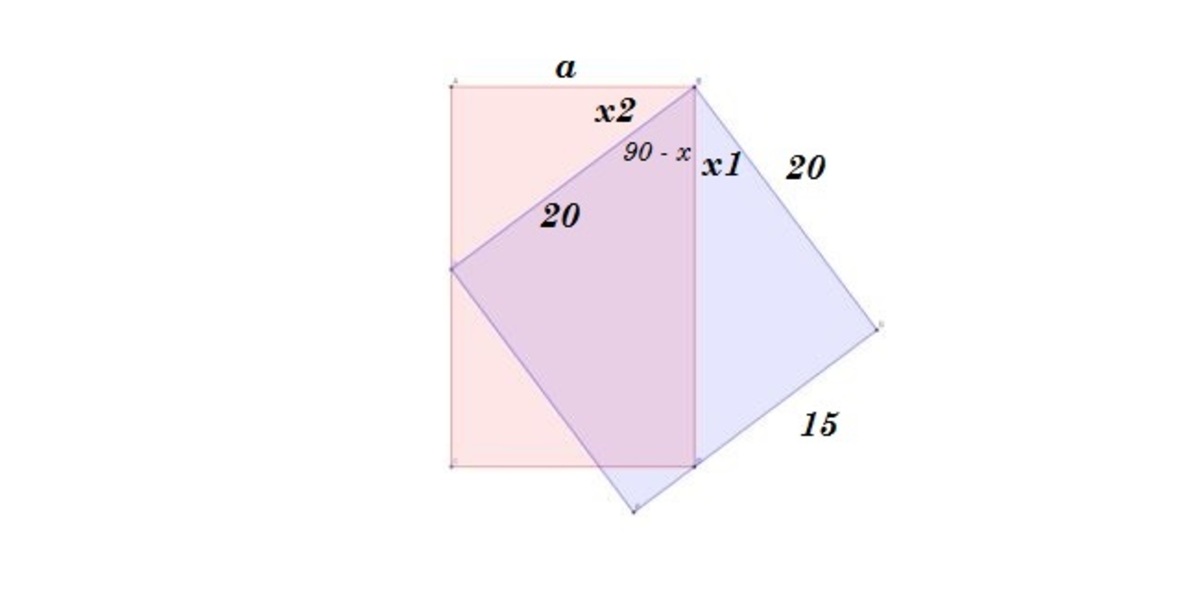Nocturne No.1
 The diagram shows a red rectangle with one of its vertices on one side of the square, and a blue square with one of its vertices on one side of the rectangle, both of which share a vertex.
The diagram shows a red rectangle with one of its vertices on one side of the square, and a blue square with one of its vertices on one side of the rectangle, both of which share a vertex.
Given that the length of the rectangle is 25 and the length of the square is 20, find the width of the rectangle.
The answer is 16.
This section requires Javascript.
You are seeing this because something didn't load right. We suggest you, (a) try
refreshing the page, (b) enabling javascript if it is disabled on your browser and,
finally, (c)
loading the
non-javascript version of this page
. We're sorry about the hassle.
12 solutions
Very clever.
Log in to reply
Do you feel cheated :)
superb observation Sir!!!!!!!!!!!!!!!
How do we know that that is half the area of both though? We are not even given that the diagram is to scale, just that a vertex is shared, that the square has side 20 and the rectangle length 25. Obviously this worked here, but is there any justification for this?
Log in to reply
I solved this with similar triangles, and initially struggled to accept this simple observation. I can't explain mathematically, but I can see the reasoning now. Btw, the scale would not be an issue - again I can't explain. Is there a way to explain?
Log in to reply
Yes. Because the rectangle and the triangle have the same base and height, the triangle has half of the area of the rectangle.
A o f R e c t a n g l e = b h
A o f T r i a n g l e = 2 1 b h
We can use this same method for the square.
Ah man, such a simple solution! Nice, my method was a lot more time consuming. Good Job! :)
Brilliant Solution
well played
Triangle ABG is similar to triangle BCE by AAA property. The rest is shown in figure.
Good job - that solution actually makes sense to me.
there is no AAA congruence rule. though the answer is right, the method is wrong
Log in to reply
Note that he is using AAA similarity, not congruence.
 Imgur
Imgur
Note that the marked red and blue triangles are all similar. Thus, we obtain the ratio 2 0 2 5 = x 2 0 ⟹ x = 1 6 .
clear and simple...nice
Smart and simple one!
 20×20÷25=16 ; This is one method.
20×20÷25=16 ; This is one method.
In other method, for this diagram we can prove that The area of Square and Rectangle are equal. Hence b=16
I had a different approach but would be curious to see how you figured this out!
Log in to reply
Madam, I hope solution is clear and compact. Your comments/ suggestions are welcome. Please let me your approach.
I like it. bt how is "area of rectange = area of square"?? can u plz explain?
Exactly how I've just solved it! Only not as neatly as this writing!!!
Lol. Solved it using sine law. Clearly not clever enough to see that halfsies thing.
I wasn't sure so I hit 16 because it seemed likely and it was!
We can observe a triangle labelled x and z where we notice that :
Base = 1/2 * 25 = 12.5
and , hence the width (x) = 20^2 - (12.5)^2 <From Pythagoras Theorem
Hence x = 15.6 \approx 16 < Hence Answer
I just looked at it and thought the most common triangle is the 3-4-5 triangle. since the hypotinus was 20 I figured my best options were 12 and 16. Ta-da
The rightmost triangle is congruent to the upper left triangle. We see that the ratio of the hyptenuses is 5:4, and such the side similar to the width of the rectangle (being a side of the square) is 4/5 * 20, = 16
Personally I like solving problems with nice complex formulas so...
The Pythagorean Theorem can be used to find all the sides of the larger blue triangle (15,20,25 or a 3:4:5 ratio). You can prove that the top red triangle and larger blue triangle are similar through a Hypotenuse-Leg proof therefore allowing you to set the two triangles in ratio to one another or in ratio to 3:4:5. The width of the rectangle is the "4" in that ratio so let's use the given information (the length of the square) to finally set up our equation...
X/20=4/5
X=16

x 1 + ( 9 0 − x ) = x 2 + ( 9 0 − x ) = 9 0
so
x 1 = x 2 = x
t a n ( x 1 ) = 2 0 1 5 = 0 . 7 5 = t a n ( x )
a = 2 0 c o s ( x ) = 2 0 c o s ( a r c t a n ( 0 . 7 5 ) ) = 1 6
Nocturne No.1 Commentary
Notice how the purple area is half of the rectangle and half of the square.
Therefore the rectangle and the square have the same area.
The width of the rectangle can then be easily found to be .
.